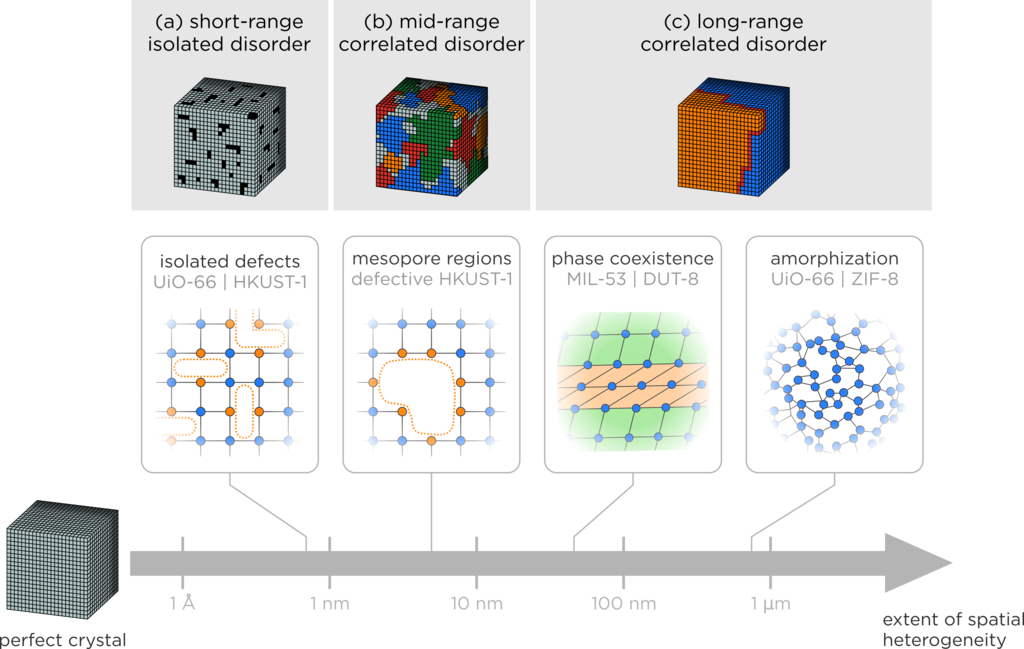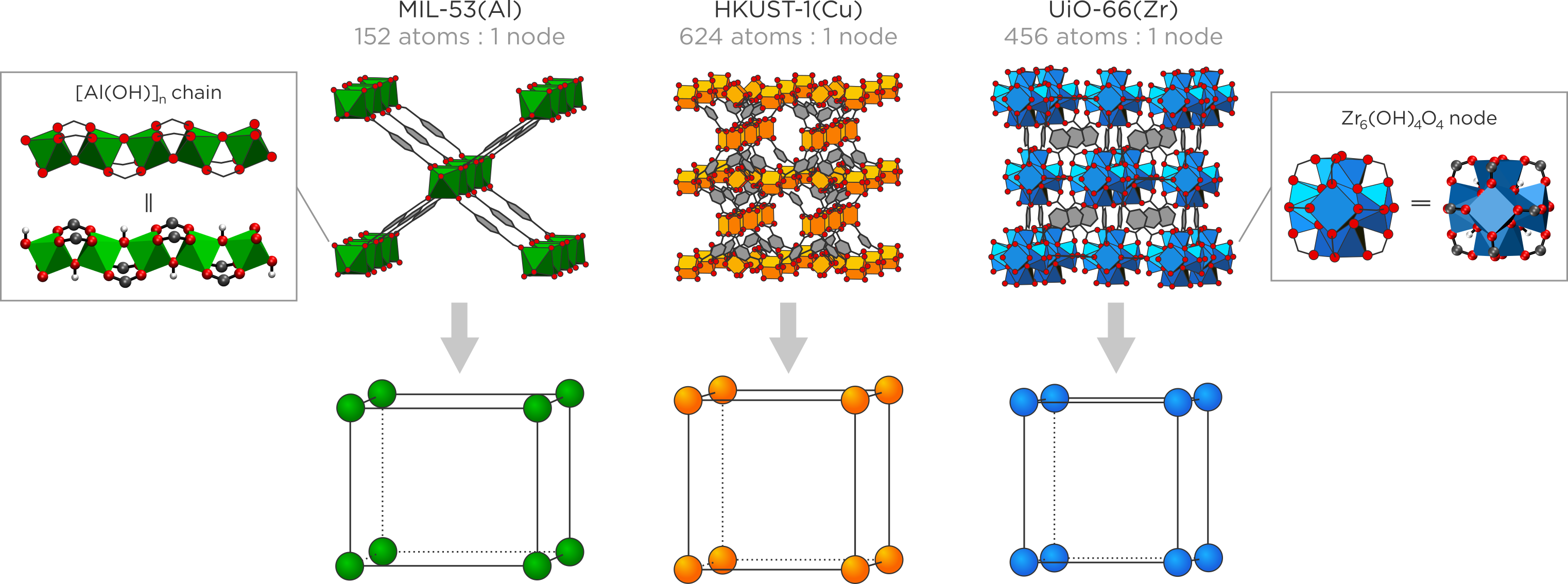It's all about time: Understanding the impact of coarse graining on accelerated diffusion in nanoporous materials
It's all about time: Understanding the impact of coarse graining on accelerated diffusion in nanoporous materials
Promotor(en): V. Van Speybroeck /20MODEV11 / Model and software developmentProbleemstelling:
In the past decade, the advance of high-performance computing facilities and new algorithms has hugely boosted the design of novel materials such as metal-organic frameworks (MOFs) for a wide variety of applications. MOFs are largely ordered nanoporous materials that attract great interest given their structural porosity and large tunability in terms of chemical and physical properties that is only seldom displayed in more conventional materials. In recent years, developments in spectroscopic techniques have demonstrated that MOFs are not perfect crystals, but inherently exhibit spatial heterogeneity in various forms, such as isolated defects and disordered domains (see Figure 1), which strongly impacts the MOF’s performance [1]. However, from a modelling perspective, these materials are to a large extent still treated as perfectly ordered systems, such that a MOF crystal can be easily modelled by periodically repeating much smaller subunits that neglect spatial disorder. One of the grand challenges in computationally modelling MOFs is therefore to correctly include spatial disorder in these materials and provide a fundamental understanding on how this impacts the material’s properties under real-life conditions. Coarse-grained (CG) models form an attractive pathway to push the length scale that can be computationally modelled beyond a few nanometers– a prerequisite to model correlated disorder. While multiple CG techniques have already been developed and have become very popular for biomolecular systems, such as the MARTINI force field [2], CG force fields for MOFs are still very scarce [3, 4].

As CG models collect atoms into coarser beads (see for instance Figure 2), the interactions between these beads are typically much smoother compared to the atomistic description. As a result of this loss of molecular roughness, the movement of particles in a CG description is accelerated compared to an all-atom description [5, 6, 7]. The advantage of this artificial acceleration of time is that more relevant configurations can be sampled in only a fraction of the computer time necessary to sample the corresponding atomistic configurations. However, this coarse-graining of time in molecular simulations is only poorly understood, leading to the fundamental question: what is the meaning of time in a CG simulation? The concept of a CG acceleration factor has recently been introduced for homogeneous solvents [6, 7], but its extension to describe diffusion in nanoporous materials remains elusive. Furthermore, the presence of spatial disorder in MOFs forms an extra challenge to obtain fundamental physical insight in the origin of this acceleration factor, which is a prerequisite to accurately simulate diffusion in disordered MOFs.

Doelstelling:
To thoroughly investigate the concept of time within CG molecular dynamics simulations, we will consider the industrially relevant case of methane and carbon dioxide diffusion in UiO-66. For this rigid MOF, both in-house atomistic data and experimental data on the diffusion of these molecules are available [8]. The UiO-66 material is a showcase example where different types of disorder are present, as indicated in Figure 3, so that accurately modelling this material requires the introduction of larger models (see Figure 2) [9]. As the diffusion of guest species is typically a kinetic process, a proper description of the time evolution of the system is required. Within this thesis, it is the aim to systematically study how methane and carbon dioxide diffuse through atomistic and different CG models of this material. Both defect-free and defective atomistic models will be studied and compared with the CG model. As such, insight into the different factors influencing the speed-up factor in coarse-graining will be obtained. Inspired by recent similar studies on CG diffusion in pure solvents [6, 7], the aim of this thesis is therefore to propose a systematic approach to define time in CG simulations for nanoporous materials. If successful, these results can be further extended to explore time for other dynamic phenomena in MOFs, such as phase transitions and rate constants.

The student will be actively coached to make him/her acquainted with the several advanced simulation and coarse-graining techniques early in the thesis year, and to transfer necessary programming skills needed to perform the research. A strong interest in programming is, however, a prerequisite.
- Study programmeMaster of Science in Engineering Physics [EMPHYS], Master of Science in Physics and Astronomy [CMFYST]KeywordsMetal-organic frameworks, Molecular simulation, force field, hierarchical models, spatial disorder, DiffusionReferences
[1]
I. L. C. Buurmans and B. M. Weckhuysen, "Heterogeneities of individual catalyst particles in space and time as monitored by spectroscopy," Nat. Chem., vol. 4, pp. 873-886, 2012.
[2]
S. J. Marrink, H. J. Risselada, S. Yefimov, D. P. Tieleman and A. H. de Vries, "The MARTINI Force Field: Coarse Grained Model for Biomolecular Simulations," J. Phys. Chem. B, vol. 111, no. 27, pp. 7812-7824, 2007.
[3]
J. P. Dürholt, R. Galvelis and R. Schmid, "Coarse graining of force fields for metal-organic frameworks," Dalton Trans., vol. 45, no. 10, pp. 4370-4379, 2016.
[4]
S. M. J. Rogge, "The micromechanical model to computationally investigate cooperative and correlated phenomena in metal-organic frameworks," Faraday Discuss., 2020. DOI: 10.1039/C9FD00148D.
[5]
T. Negami, K. Shimizu and T. Terada, “Coarse-grained molecular dynamics simulations of protein-ligand binding,” J. Comput. Chem., vol. 35, no. 25, pp. 1835-1845, 2014.
[6]
J. G. E. M. Fraaije, J. van Male, P. Becherer and R. Serral Gracià, “Calculation of Diffusion Coefficients through Coarse-Grained Simulations Using the Automated-Fragmentation-Parametrization Method and the Recovery of Wilke–Chang Statistical Correlation,” J. Chem. Theory Comput., vol. 14, no. 2, pp. 479-485, 2018.
[7]
M. K. Meinel and F. Müller-Plathe, "Loss of molecular roughness upon coarse-graining predicts the artificially accelerated mobility of coarse-grained molecular simulation models," J. Chem. Theory Comput., 2020. DOI: 10.1021/acs.jctc.9b00943.
[8]
Q. Yang, H. Jobic, F. Salles, D. Kolokolov, V. Guillerm, C. Serre and G. Maurin, “Probing the Dynamics of CO2 and CH4 within the Porous Zirconium Terephthalate UiO‐66(Zr): A Synergic Combination of Neutron Scattering Measurements and Molecular Simulations,” Chem. Eur. J., vol. 17, no. 32, pp. 8882-8889, 2011.
[9]
S. M. J. Rogge, J. Wieme, L. Vanduyfhuys, S. Vandenbrande, G. Maurin, T. Verstraelen, M. Waroquier and V. Van Speybroeck, "Thermodynamic Insight in the High-Pressure Behavior of UiO-66: Effect of Linker Defects and Linker Expansion," Chem. Mater., vol. 28, no. 16, pp. 5721-5732, 2016.
